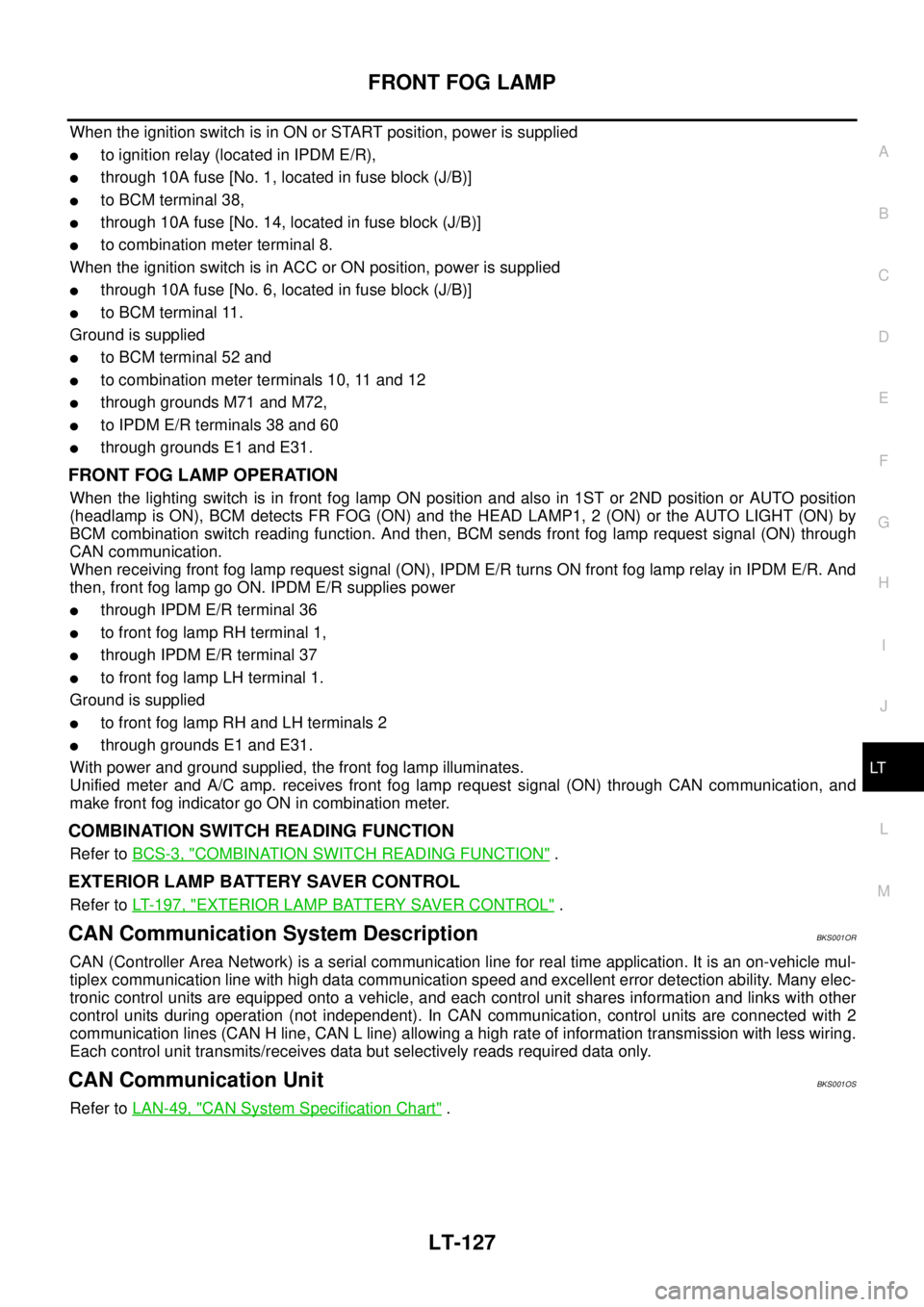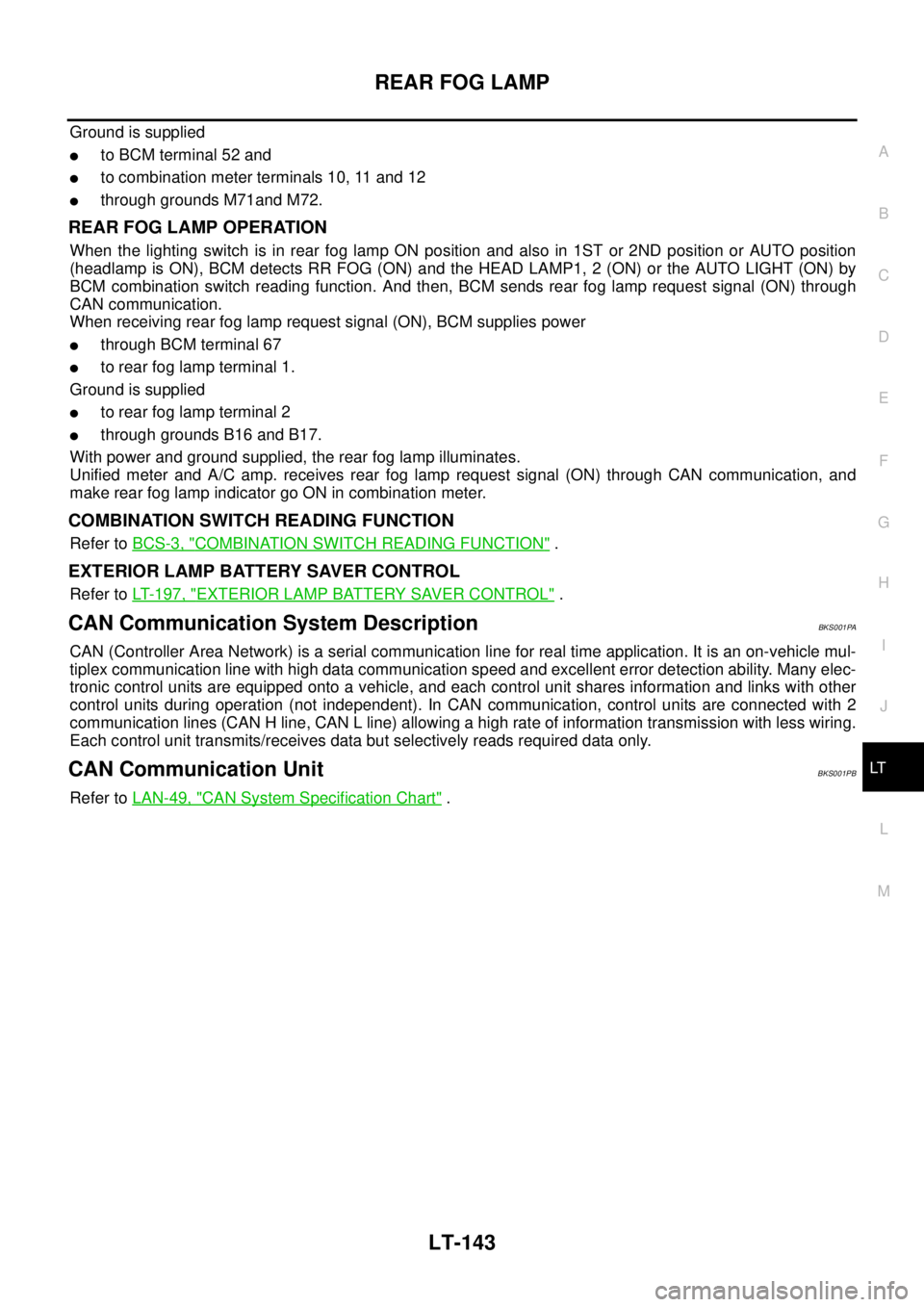Page 2809 of 3502
HEADLAMP AIMING CONTROL (MANUAL)
LT-121
C
D
E
F
G
H
I
J
L
MA
B
LT
HEADLAMP AIMING CONTROL (MANUAL)PFP:25190
SchematicBKS001OL
TKWM4578E
Page 2810 of 3502
LT-122
HEADLAMP AIMING CONTROL (MANUAL)
Wiring Diagram — H/AIM —BKS001OM
TKWM4579E
Page 2811 of 3502
HEADLAMP AIMING CONTROL (MANUAL)
LT-123
C
D
E
F
G
H
I
J
L
MA
B
LT
TKWM1613E
Page 2812 of 3502
LT-124
HEADLAMP AIMING CONTROL (MANUAL)
TKWM4580E
Page 2813 of 3502
HEADLAMP AIMING CONTROL (MANUAL)
LT-125
C
D
E
F
G
H
I
J
L
MA
B
LT
Removal and InstallationBKS001ON
REMOVAL
1. Remove instrument driver lower panel. Refer to IP-10,
"INSTRUMENT PANEL ASSEMBLY" .
2. Press pawl on reverse side and remove the headlamp aiming
switch.
INSTALLATION
Installation is the reverse order of removal.
Switch Circuit InspectionBKS001OO
Using a circuit tester, check continuity between the headlamp aiming
switch connector terminals in each operation status of the aiming
switch.
SKIB0896E
SKIB8648J
Page 2815 of 3502

FRONT FOG LAMP
LT-127
C
D
E
F
G
H
I
J
L
MA
B
LT
When the ignition switch is in ON or START position, power is supplied
�to ignition relay (located in IPDM E/R),
�through 10A fuse [No. 1, located in fuse block (J/B)]
�to BCM terminal 38,
�through 10A fuse [No. 14, located in fuse block (J/B)]
�to combination meter terminal 8.
When the ignition switch is in ACC or ON position, power is supplied
�through 10A fuse [No. 6, located in fuse block (J/B)]
�to BCM terminal 11.
Ground is supplied
�to BCM terminal 52 and
�to combination meter terminals 10, 11 and 12
�through grounds M71 and M72,
�to IPDM E/R terminals 38 and 60
�through grounds E1 and E31.
FRONT FOG LAMP OPERATION
When the lighting switch is in front fog lamp ON position and also in 1ST or 2ND position or AUTO position
(headlamp is ON), BCM detects FR FOG (ON) and the HEAD LAMP1, 2 (ON) or the AUTO LIGHT (ON) by
BCM combination switch reading function. And then, BCM sends front fog lamp request signal (ON) through
CAN communication.
When receiving front fog lamp request signal (ON), IPDM E/R turns ON front fog lamp relay in IPDM E/R. And
then, front fog lamp go ON. IPDM E/R supplies power
�through IPDM E/R terminal 36
�to front fog lamp RH terminal 1,
�through IPDM E/R terminal 37
�to front fog lamp LH terminal 1.
Ground is supplied
�to front fog lamp RH and LH terminals 2
�through grounds E1 and E31.
With power and ground supplied, the front fog lamp illuminates.
Unified meter and A/C amp. receives front fog lamp request signal (ON) through CAN communication, and
make front fog indicator go ON in combination meter.
COMBINATION SWITCH READING FUNCTION
Refer to BCS-3, "COMBINATION SWITCH READING FUNCTION" .
EXTERIOR LAMP BATTERY SAVER CONTROL
Refer to LT- 1 9 7 , "EXTERIOR LAMP BATTERY SAVER CONTROL" .
CAN Communication System DescriptionBKS001OR
CAN (Controller Area Network) is a serial communication line for real time application. It is an on-vehicle mul-
tiplex communication line with high data communication speed and excellent error detection ability. Many elec-
tronic control units are equipped onto a vehicle, and each control unit shares information and links with other
control units during operation (not independent). In CAN communication, control units are connected with 2
communication lines (CAN H line, CAN L line) allowing a high rate of information transmission with less wiring.
Each control unit transmits/receives data but selectively reads required data only.
CAN Communication UnitBKS001OS
Refer to LAN-49, "CAN System Specification Chart" .
Page 2828 of 3502
LT-140
FRONT FOG LAMP
Aiming AdjustmentBKS001P5
The front fog lamp is a semi-sealed beam type which uses a replaceable halogen bulb. Before performing
aiming adjustment, make sure of the following.
�Keep all tires inflated to correct pressure.
�Place vehicle on level ground.
�See that vehicle is unloaded (except for full levels of coolant, engine oil and fuel, and spare tire, jack, and
tools). Have the driver or equivalent weight placed in driver seat.
Adjust aiming in the vertical direction by turning the adjustment screw.
1. Set the distance between the screen and the center of the front
fog lamp lens as shown in the figure.
2. Turn front fog lamps ON.
3. Adjust front fog lamps using adjusting screw so that the main
optical axis of the high intensity zone is in the figure.
�When performing this adjustment, cover the headlamps and
the opposite front fog lamp, if necessary.
PKIC9407E
SKIB8679E
SKIB8680E
Page 2831 of 3502

REAR FOG LAMP
LT-143
C
D
E
F
G
H
I
J
L
MA
B
LT
Ground is supplied
�to BCM terminal 52 and
�to combination meter terminals 10, 11 and 12
�through grounds M71and M72.
REAR FOG LAMP OPERATION
When the lighting switch is in rear fog lamp ON position and also in 1ST or 2ND position or AUTO position
(headlamp is ON), BCM detects RR FOG (ON) and the HEAD LAMP1, 2 (ON) or the AUTO LIGHT (ON) by
BCM combination switch reading function. And then, BCM sends rear fog lamp request signal (ON) through
CAN communication.
When receiving rear fog lamp request signal (ON), BCM supplies power
�through BCM terminal 67
�to rear fog lamp terminal 1.
Ground is supplied
�to rear fog lamp terminal 2
�through grounds B16 and B17.
With power and ground supplied, the rear fog lamp illuminates.
Unified meter and A/C amp. receives rear fog lamp request signal (ON) through CAN communication, and
make rear fog lamp indicator go ON in combination meter.
COMBINATION SWITCH READING FUNCTION
Refer to BCS-3, "COMBINATION SWITCH READING FUNCTION" .
EXTERIOR LAMP BATTERY SAVER CONTROL
Refer to LT- 1 9 7 , "EXTERIOR LAMP BATTERY SAVER CONTROL" .
CAN Communication System DescriptionBKS001PA
CAN (Controller Area Network) is a serial communication line for real time application. It is an on-vehicle mul-
tiplex communication line with high data communication speed and excellent error detection ability. Many elec-
tronic control units are equipped onto a vehicle, and each control unit shares information and links with other
control units during operation (not independent). In CAN communication, control units are connected with 2
communication lines (CAN H line, CAN L line) allowing a high rate of information transmission with less wiring.
Each control unit transmits/receives data but selectively reads required data only.
CAN Communication UnitBKS001PB
Refer to LAN-49, "CAN System Specification Chart" .